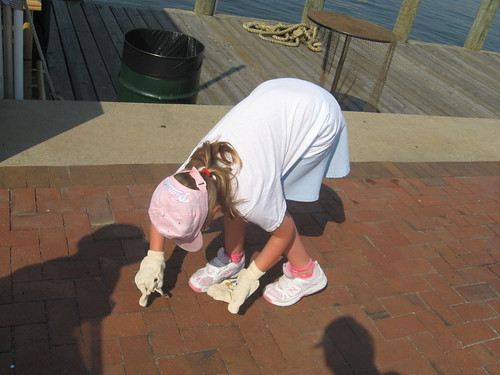On Saturday, Ben and Shira attended the Save the Bay Day organized by the Elizabeth River Project where they helped pick up trash along the Elizabeth River.


It's amazing how good doing mitzvot (good deeds) makes the children feel. I've built a strong anti-litter ethic in my kids and they often ask if they can don gloves and walk around the neighborhood picking up trash. They consider it being a good neighbor.
The first time they were introduced to this concept was when they were around three and we came across a neighbor's car that had been broken into. There was glass all over the road. This neighbor is elderly, so we swept up the glass for him. I find it fascinating how this simple act has stayed with the kids for all these years.
My anti-litter campaign has had interesting results. I forgot that 7 year olds see the world in black and white. The kids have now become passionate anti-litter campaigners and speak out loudly when they see littering happening.
Anyway, back to the Elizabeth River and the Chesapeake Bay. Here is what the Elizabeth River Project" has to say about the River.
To accommodate modern lives, not just in Portsmouth but also Norfolk, Chesapeake and Virginia Beach, the Elizabeth River started to be filled to two-thirds her normal width and dredged to twice her normal depth. Now what do you suppose has happened to the wetlands and shallows that once supported the abundant crabs and fish? Yes, our Elizabeth River has lost 50 percent of her tidal wetlands and her shores have been converted to concrete as much as six miles at a stretch. Wetlands are amazing ecosystems that help filter nitrogen, control erosion, serve as habitat and are as precious as coral reefs.
Into the 1900s, the harvest of oysters was banned due to contamination from sewage and is still banned today. And down the Southern Branch there is a site known as Money Point where wood treatment facilities coated the great timbers with tar, made into “creosote” and let it drip and wash into the river bottom. Now what’s the problem with that? Scientists say the creosote pooled on the bottom of the Elizabeth’s Southern Branch and represents some of the highest concentrations in the world --- and that’s associated with cancer in our fish and risks to human health.
Now for a bit of hope, early as 1940 your communities realized they wanted a healthy river, not just a great harbor. Hampton Roads Sanitation District began the job of managing your sewage. In 1991 four citizens founded the Elizabeth River Project around a kitchen table based on the belief that citizens, government and industry can work together, hand in hand, to achieve the balance of a healthy river and a healthy economy. Out of such an unusual idea was born a most powerful partnership. Today we see the powerful results on every shore, brought about by dozens of industries, government partners and ordinary citizens, rallying for your river’s restoration! The industrial stewards are called River Stars!
In 1999 the Norfolk Naval Station, the world’s largest naval base located at the mouth of our Elizabeth was named the first Model Level River Star with the Elizabeth River Project for voluntary progress reducing pollution and restoring vital habitat. Today we have 60 River Star industries participating, including almost every one of the largest industrial interests on the river, and this year alone they documented reducing pollution by 3.4 million pounds! Not only are today’s port facilities reducing pollution. They’re bringing back the green shore. In fact in 2004, one of our River Stars, Norfolk Naval Shipyard, actually won an award from the White House for restoring a wetland. The Naval shipyard wetlands are part of a project that the national head of the US Environmental Protection Agency has called a model for the nation!
And as for that nasty creosote creating fish cancer on the Southern Branch - the Elizabeth River Project is helping coordinate not one but three cleanup projects with public and private partners. Soon the goo will be gone from Elizabeth’s bottom! And what about the oysters that once each made a meal for early residents. Partners have restored more oyster reefs on the Elizabeth than anywhere on the Chesapeake Bay! One can look along the shore and you’ll see them growing today on every piling. In fact, by the year 2000, the Elizabeth River showed the MOST IMPROVING TRENDS for water quality on the entire Chesapeake Bay! But she still has a long way to go and each of us has a chance to be part of this legend.
The Elizabeth River Project is not the only organization working on rehabilitating the Bay.
Bob Vorth of the Virginia Institute of Marine Science (VIMS) has spearheaded a project that has planted 1,400 continuous acres of eel grass, the largest sea grass restoration in the world, in the Chesapeake Bay at the Eastern Shore. His objective this week is to capture about 20 million seeds from existing plants, cure them in a new facility just opened in the town of Oyster, and spread them around this fall in the coastal bays, as well as in the York and James rivers off the Chesapeake.
This is vital to the rehabilitation of the bay. As without grasses, the Bay lacks habitat for crabs and shellfish and does not breathe life-sustaining oxygen into the water as before.
You can read the entire article here.













2 comments:
good on your kids
Jen
So... how do libertarians feel about cleaning up other people's messes? Hehehe. I would guess a libertarian would say it wasn't fair but it was decent. That's what I would say anyway.
And in any case, it's good to make them aware of littering!
Post a Comment